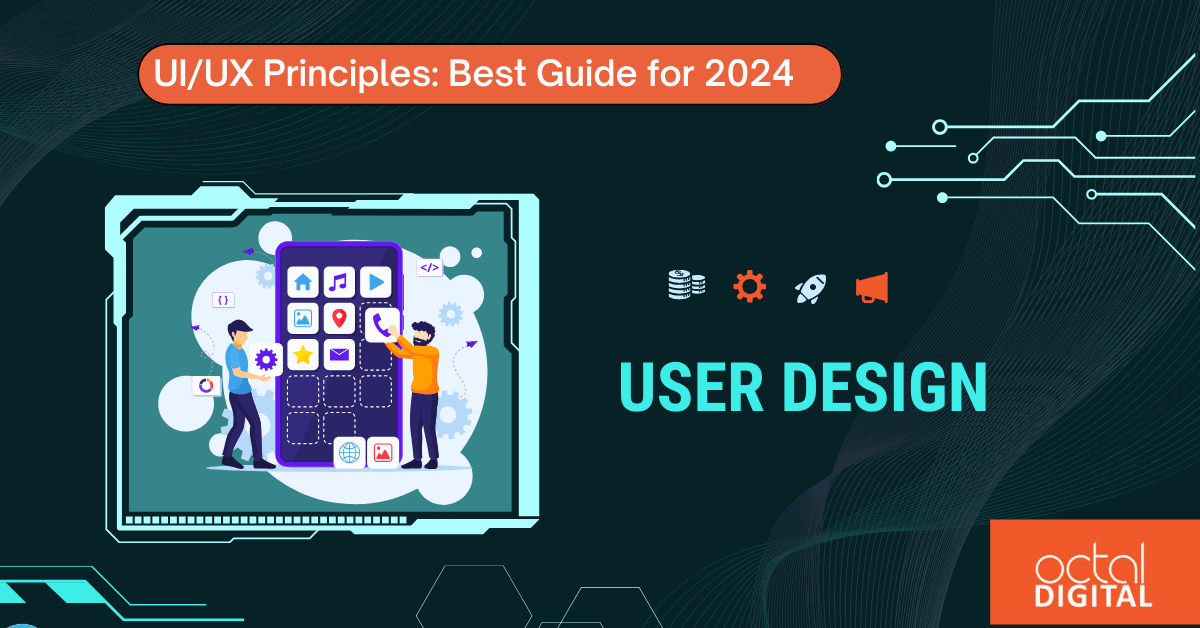User Interface (UI) and User Experience (UX) design are integral components of creating digital products that are not only visually appealing but also user-friendly. UI design focuses on the look and feel of the product, encompassing elements like color, typography, and icons. On the other hand, UX design involves the overall user journey, from research and wireframing to prototyping and testing, ensuring a seamless and satisfying experience.
The importance of UI/UX design lies in its ability to enhance user satisfaction and engagement. This blog aims to delve into the fundamentals of UI/UX design, providing a comprehensive guide for both beginners and experienced UI/UX designers.
1. Fundamentals: What is UI Design?
UI (User Interface) design refers to the process of creating visually appealing and interactive interfaces for digital products, with the primary goal of enhancing user experience and satisfaction. The purpose of UI design is to ensure that the user can easily interact with the system or application, guiding them through a seamless and intuitive journey.
Key Elements:
-
Color:
- Color psychology: Understanding the psychological impact of colors on users and choosing a palette that aligns with the brand and evokes the desired emotions.
- Contrast: Ensuring sufficient contrast between foreground and background elements to enhance readability and accessibility.
- Consistency: Maintaining a consistent color scheme throughout the interface to create a unified visual identity.
-
Typography:
- Font selection: Choosing appropriate fonts that are legible and convey the brand’s personality.
- Hierarchy: Establishing a clear hierarchy through font size, weight, and spacing to guide users through content.
- Readability: Ensuring text is easily readable across various devices and screen sizes.
-
Icons:
- Symbolism: Using icons that are universally recognized or providing clear tooltips to convey their meaning.
- Consistency: Maintaining a consistent visual style for icons across the interface for coherence.
-
Layout:
- Grid systems: Implementing grid-based layouts for alignment and organization of elements, contributing to a clean and structured design.
- White space: Leveraging white space strategically to improve readability and reduce visual clutter.
- Responsive design: Designing interfaces that adapt seamlessly to different screen sizes and devices.
Utilize the power of user-centric design! Let Octal Digital create seamless and intuitive experiences that resonate with your users. Our expert designers blend aesthetics with functionality to ensure every click is a delight. Reach out to us for an interface that leaves a lasting impression. We conduct user research to gain insights into your audience’s preferences and pain points. This research gives us insights into design process, ensuring the final product aligns perfectly with user expectations.
Principles of UI Design:
-
Consistency:
- Visual consistency: Ensuring a uniform appearance across the interface, including colors, fonts, and styling, to provide a cohesive user experience.
- Functional consistency: Maintaining consistent interactions and behaviors for similar elements throughout the application.
-
Feedback:
- User feedback: Providing immediate and clear feedback in response to user actions to confirm the success or failure of their interactions.
- System feedback: Communicating loading states, errors, and other system status updates to keep users informed about the application’s state.
-
Efficiency:
- Task efficiency: Designing interfaces that enable users to accomplish tasks quickly and with minimal steps.
- Cognitive load: Minimizing cognitive load by simplifying complex tasks, presenting information logically, and guiding users through the interface seamlessly.
Also, read our recommended blog on App Analytics: Comprehensive Guide to Mobile App Analytics in 2024
2. Fundamentals: What is UX Design?
UX (User Experience) design involves creating a seamless and enjoyable interaction between users and a product or service. It encompasses every aspect of the user’s interaction, aiming to meet their needs and provide a positive overall experience. The primary purpose of UX design is to enhance user satisfaction by making products more accessible, usable, and enjoyable. It involves understanding user behaviors, preferences, and pain points to design solutions that align with user expectations.
Key Components:
-
User Research:
- Methods: Employing various research methods such as surveys, interviews, and usability testing to gather insights into user behaviors and preferences.
- Integration: Integrating user research findings throughout the design process to inform decision-making and validate design choices.
-
Information Architecture:
- Structure: Organizing and structuring content and information in a way that is logical and intuitive for users.
- Navigation: Designing clear navigation paths and hierarchies to help users easily find and access relevant information.
-
Wireframing:
- Sketching: Creating low-fidelity sketches or wireframes to outline the basic structure and layout of a user interface.
- Functionality: Defining the functional elements and their placement, focusing on content prioritization and user interactions.
-
Prototyping:
- Interactive Models: Building interactive prototypes to simulate the user experience and test the functionality of the design.
- User Feedback: Using prototypes for usability testing, allowing users to interact with the design and providing valuable feedback for refinement.
Principles of UX Design:
-
Usability:
- Efficiency: Ensuring that users can accomplish tasks efficiently with minimal friction.
- Learnability: Designing interfaces that are easy to learn, reducing the time required for users to become proficient.
- Error Prevention and Recovery: Implementing features to prevent errors and providing clear recovery paths when mistakes occur.
-
Accessibility:
- Inclusive Design: Creating designs that are accessible to users with disabilities, ensuring a broad range of people can use the product.
- Compliance: Adhering to accessibility standards (e.g., WCAG) to guarantee that the product is usable by individuals with various abilities.
-
Consistency:
- Visual Consistency: Maintaining a uniform visual style across the interface, including colors, fonts, and icons.
- Functional Consistency: Ensuring consistent interactions and behaviors for similar elements throughout the product, reducing cognitive load for users.
Utilize the power of user-centric design! Let Octal Digital create seamless and intuitive web design services that speak with your users. Our expert designers blend aesthetics with functionality to ensure every click is a delight. We conduct user research to gain insights into your audience’s preferences and pain points. This research gives us insights into the design process, ensuring the final product aligns perfectly with user expectations. Reach out to us for an interface that leaves a lasting impression!
3. User Research
Importance of User Research in Design:
User research is crucial for gathering insights into user behaviors, preferences, and needs, forming the foundation for informed decision-making, and ensuring that design solutions align with user expectations. Systematically studying users helps identify pain points, validate assumptions, and create products that meet user goals.
Methods User Research:
-
Surveys and Questionnaires:
- Implementation: Design clear survey questions for quantitative data.
- Sampling: Ensure a representative sample for reliable conclusions.
- Analysis: Use statistical tools to identify patterns and make informed decisions.
-
Interviews:
- Structured: Ask predefined questions for consistency.
- Open-Ended: Allow free expression for qualitative insights.
- Empathy: Actively listen to understand perspectives and nuanced feedback.
-
Observational Studies:
- Contextual Inquiry: Observe users in natural settings for real-world insights.
- Task Analysis: Break down tasks to identify pain points and improvements.
- Ethnographic Research: Immerse in user contexts for deeper insights.
-
Analytics and Heatmaps:
- User Analytics: Use tools like Google Analytics for tracking interactions.
- Heatmaps: Analyze visual representations of user interactions.
- Click Tracking: Identify popular click areas to optimize user journeys.
-
Card Sorting:
- Open Card Sorting: Let users categorize content based on their logic.
- Closed Card Sorting: Assess user agreement with predefined categories.
- Information Architecture Validation: Refine hierarchies based on user feedback.
-
Usability Testing:
- Task Scenarios: Define realistic tasks for users.
- Think-Aloud Protocol: Encourage users to vocalize thoughts during testing.
- Iterative Testing: Conduct multiple rounds to refine the design based on feedback.
-
Remote Testing:
- Online Platforms: Use remote tools for global outreach.
- Screen Sharing: Facilitate real-time observation of user interactions.
- Remote Moderation: Conduct interviews and tests remotely for convenience.
4. Information Architecture
Information Architecture (IA) involves organizing, structuring, and labeling content in a way that facilitates effective navigation and retrieval of information within a system or product. The primary purpose of IA is to enhance user understanding and interaction by providing a clear and intuitive structure to the information within a digital product. It aims to make information easily accessible, reducing cognitive load for users and improving overall usability.
Organizing Information Effectively:
Card Sorting:
- Process: Users categorize content for meaningful groups.
- Implementation: Conduct open and closed card sorting sessions.
- Analysis: Inform information hierarchies and structures.
Tree Testing:
- Setup: Simplified text-based info architecture without visual design.
- Task-Based Testing: Users locate info within the tree structure.
- Analysis: Assess navigation efficiency and identify confusion.
Wireframing:
- Low-Fidelity Design: Basic UI skeletal representations.
- Content Placement: Define element placement based on info architecture.
- Iterative Refinement: Use wireframes for iterative design and feedback.
Sitemaps:
- Visual Representation: Display hierarchical structure visually.
- Navigation Planning: Identify key paths and relationships.
- Communication Tool: Share and discuss with stakeholders for alignment.
Metadata Design:
- Labeling and Tagging: Define clear labels for navigation.
- Search Optimization: Use metadata to enhance search.
- User Understanding: Ensure labels resonate with users.
Navigation Design:
- Navigation Patterns: Choose patterns based on user needs.
- Consistency: Maintain consistent navigation elements.
- User Feedback: Test effectiveness through user feedback and analytics. Adjust as needed.
5. Wireframing and Prototyping
Wireframing
- Definition: Creating low-fidelity digital interface blueprints.
- Purpose: Maps skeletal UI structure, guides design, and facilitates collaboration.
Tools and Techniques:
- Wireframing Tools: Balsamiq, Axure, or Sketch for digital wireframes.
- Paper and Pen: Traditional sketching for quick ideation.
- Responsive Design: Ensures wireframes adapt to different screen sizes.
- Feedback Loop: Iteratively refine based on stakeholder and usability testing feedback.
Prototyping
- Definition: Creating interactive digital models for user interaction simulation.
- Purpose: Validates design concepts, gathers user feedback, and ensures the final product meets expectations.
Low-Fidelity vs. High-Fidelity Prototypes:
- Low-Fidelity Prototypes: Basic representation for rapid core concept testing.
- High-Fidelity Prototypes: Closer to the final design, evaluates aesthetics, and gathers detailed feedback.
Interactive Prototyping Tools:
- InVision: Creates interactive prototypes, collaborates, and gathers feedback.
- Figma: Enables collaborative design and prototyping.
- Axure RP: Suitable for both low and high-fidelity with advanced interactivity.
- Adobe XD: Facilitates design and prototyping, and integrates with Adobe Creative Cloud.
Advantages:
- User Testing: Enables realistic user testing scenarios.
- Stakeholder Communication: Effectively conveys design concepts to non-design stakeholders.
- Iterative Design: Allows rapid iteration based on user feedback.
6. UI Design Best Practices
A) Color Theory
Color Schemes:
- Complementary Colors: Opposite on the color wheel for high contrast.
- Analogous Colors: Adjacent for a harmonious palette.
- Monochromatic Colors: Variations in lightness and saturation of a single color.
- Triadic Colors: Three evenly spaced colors for balance.
Accessibility Considerations:
- Color Contrast: Ensure readable text-background contrast per WCAG guidelines.
- Color Blindness: Confirm color choices for users with vision deficiencies.
- Text Alternatives: Provide non-color indicators for all users.
B) Typography
Font Selection:
- Readability: Choose legible fonts considering stroke width and spacing.
- Brand Alignment: Select fonts aligning with the brand’s personality.
- Font Pairing: Combine contrasting fonts for hierarchy and cohesion.
Hierarchy and Readability:
- Heading Structure: Establish clear hierarchy with varied size, weight, and style.
- Line Spacing: Set appropriate leading for readability.
- Text Alignment: Align text consistently for a polished appearance.
C) Iconography
Purpose and Usage:
- Visual Communication: Icons quickly convey meaning without heavy reliance on text.
- Functionality: Ensure icons intuitively represent actions or concepts.
Consistency in Icon Design:
- Style Guidelines: Establish and follow consistent style guides.
- Visual Unity: Ensure icons share a common visual language.
- Recognition: Prioritize recognition over uniqueness for user familiarity.
Turn clicks into conversions with our UI/UX design services. Our designs are strategically crafted to guide users through a seamless journey, maximizing engagement and conversion rates. We implement lazy loading along with image compression and leverage browser caching to streamline load times. Prioritize a fast and efficient user experience for higher engagement. Supercharge your digital presence– connect with us today!
7. Usability Testing
Importance of Usability Testing:
- Iterative Improvement: Identifies issues and gathers feedback for iterative design improvements.
- User-Centered Design: Ensures alignment with user expectations, enhancing satisfaction.
- Problem Identification: Uncovers usability issues, addressing pain points before a wider release.
Conducting Usability Tests:
Remote vs. In-Person Testing:
- In-Person Testing: Immediate feedback and real-time observation; potential diversity and logistical challenges.
- Remote Testing: Allows testing with diverse participants; challenges in environment control and nuanced behavior observation.
Test Metrics and Analysis:
- Task Success Rate: Percentage of successfully completed tasks.
- Time on Task: Measures task completion time, highlighting efficiency areas.
- Error Rate: Quantifies user errors for insights into areas needing clarification or redesign.
- Satisfaction Scores: Subjective feedback through surveys to gauge user satisfaction.
- Statistical Significance: Determines changes’ statistical significance, ensuring findings‘ validity.
- Qualitative Analysis: Supplements quantitative data with qualitative insights from user comments.
- Benchmarking: Compares usability metrics against industry standards for performance assessment.
Additional Considerations:
- Iterative Feedback: Integrates user feedback iteratively for continuous UI refinement.
- Test Moderation: Ensures neutral test moderation, avoiding leading questions.
- User Recruitment: Selects a diverse group of representative users for varied perspectives.
Inclusivity matters. Octal Digital ensures your design is accessible to users of all abilities. We comply with WCAG accessibility standards and create an inclusive user experience that resonates with a diverse audience. Let’s make your brand accessible to everyone. Our expert app and web designers conduct regular accessibility audits to identify and address potential barriers. This ongoing commitment ensures your design remains inclusive and compliant.
8. Current Trends in UI/UX Design
-
Dark Mode:
- Implementation: Inverted color schemes with CSS or JavaScript.
- Benefits: Reduces eye strain, and improves battery efficiency on OLED screens.
-
Microinteractions:
- Purpose: Subtle animations for user engagement.
- Implementation: CSS, JavaScript, or specialized UI libraries.
- Enhancement: Provides intuitive feedback, and adds delight.
-
Voice User Interface (VUI):
- Technology: NLP for language interpretation, and speech recognition integration.
- Benefits: Enables hands-free interaction, and enhances accessibility.
-
AR and VR:
- Spatial Design: Considers 3D interaction in real-world environments.
- Implementation: AR and VR SDKs like ARKit and ARCore.
- Experience: Creates immersive and interactive digital environments.
-
Neumorphism:
- Visual Style: Soft skeuomorphic design with gradients and shadows.
- Implementation: Achieved through CSS or graphic design tools.
- Considerations: Ensure contrast and readability for accessibility.
-
Motion Design and 3D Graphics:
- Interactive Animations: Motion design for engaging user experiences.
- 3D Elements: Integration of 3D graphics for dynamism.
- Optimization: Consider GPU acceleration for performance.
Latest Blog: Guide to Effective Mobile App Marketing (2024)
9. Challenges and Solutions
-
Common Challenges in UI/UX Design:
Diverse User Base:
- Challenge: Designing for diverse user needs is complex.
- Solution: Thorough user research, inclusive design, and usability testing with diverse groups.
Tight Timelines:
- Challenge: Pressure compromises design depth and quality.
- Solution: Prioritize tasks, use design systems, and communicate effectively with stakeholders.
Technology Limitations:
- Challenge: Designing for various platforms with tech constraints.
- Solution: Stay informed, collaborate with developers, and use progressive enhancement for graceful degradation.
Constantly Evolving Trends:
- Challenge: Keeping up with changing UI/UX trends is overwhelming.
- Solution: Invest in continuous learning, engage in industry communities, and balance trend adoption with timeless principles.
B) Strategies and Solutions:
Collaboration and Communication:
- Strategy: Foster open collaboration among cross-functional teams.
- Solution: Use tools like Figma, conduct regular meetings, and establish shared project goals.
Keeping Up with Technological Advances:
- Strategy: Prioritize learning and staying informed.
- Solution: Dedicate time for professional development, follow industry sources, and participate in webinars.
User-Centric Design:
- Strategy: Place the user at the center of the design process.
- Solution: Regular user research, usability testing, and feedback integration.
Design System Implementation:
- Strategy: Establish and maintain a design system for consistency.
- Solution: Document patterns, create reusable components, and update the system regularly.
Iterative Design Process:
- Strategy: Embrace an iterative design process for continuous refinement.
- Solution: Conduct usability testing, gather feedback, and iterate on designs in multiple cycles.
Addressing these challenges with strategic solutions helps UI/UX designers navigate complexities and ensure adaptability to evolving tech and user expectations.
Conclusion
UI design immerses itself in the visual elements—colors, fonts, and icons—striving for a seamless and effective appearance. On a broader scale, UX design intricately maps out the user journey, encompassing research, wireframing, and prototyping. Guided by best practices, the significance of color, typography, and icons is paramount, with a strong emphasis on accessibility. Designers grapple with challenges, from diverse user needs to tight timelines and technological constraints, navigating them with collaborative efforts, continuous learning, and a user-centric approach. Essentially, UI/UX design harmonizes creativity with technicality. Every decision molds user experiences, demanding a proactive approach to address challenges and staying attuned to industry shifts. Designers decipher the intricacies of user interaction, crafting digital experiences that ensure accessibility and inclusivity of the diverse user-bade globally due to the digital evolution.
FAQs
1. What is the primary difference between UI and UX design?
UI (User Interface) design focuses on the visual elements of digital products, while UX (User Experience) design encompasses the overall user journey, from research to testing, aiming for a seamless and satisfying experience.
2. Why is user research essential in UX design?
User research is crucial in UX design as it helps gather insights into user behaviors, preferences, and pain points. This information informs design decisions, validates choices, and contributes to creating a positive overall user experience.
3. How do UI designers ensure consistency in design elements?
UI designers ensure consistency by maintaining a uniform appearance across the interface, including colors, fonts, and styling. This visual consistency and functional consistency in interactions create a cohesive user experience.
4. Why is usability testing important, and how does it contribute to design improvement?
Usability testing is essential for identifying issues and gathering user feedback, facilitating iterative design improvements. It ensures the final product aligns with user expectations, enhancing overall user satisfaction.











